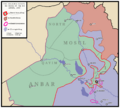Iraqi insurgency (2003–2011) facts for kids
Quick facts for kids Iraqi insurgency |
|||||||||
|---|---|---|---|---|---|---|---|---|---|
| Part of the Iraq War | |||||||||
|
|||||||||
| Belligerents | |||||||||
Sons of Iraq Supported by:
|
|
|
|
||||||
| Commanders and leaders | |||||||||
The Iraqi insurgency was a period of fighting in Iraq that started after the United States and its allies invaded in 2003. This invasion removed Saddam Hussein from power, who had been Iraq's leader for a long time. The insurgency lasted until the end of the Iraq War in 2011, when American troops left Iraq.
After the main war ended, a new Iraqi government was being formed. But many groups in Iraq were unhappy with the new government or the foreign forces. This led to a lot of violence and fighting across the country.
Contents
What Was the Iraqi Insurgency?
An insurgency is when groups of people fight against a government or an occupying force using methods like surprise attacks and bombings. The Iraqi insurgency began on May 1, 2003. It was a complex conflict with many different groups involved.
The fighting was mainly between:
- The Multi-National Force – Iraq (MNF–I), led by the United States.
- The new Iraqi security forces (the Iraqi army and police).
- Various Iraqi groups who opposed the foreign forces or the new government.
Why Did the Insurgency Start?
When Saddam Hussein's government fell in 2003, it created a power vacuum. This means there was no strong central power. Different groups then tried to gain control or resist the changes.
The first wave of violence happened between 2003 and 2006. During this time, the MNF-I was trying to help set up a new Iraqi government.
Who Were the Insurgents?
The groups fighting against the MNF-I and the new Iraqi government were very diverse. They included:
- Saddam Hussein's supporters: These were people loyal to the old government, like the Ba'ath Party.
- Local Iraqi groups: Many ordinary Iraqis were unhappy with the foreign military presence or the way the new government was being formed.
- Foreign fighters: Some fighters from other countries, often called jihadists, came to Iraq to join the fight. One well-known group was Al-Qaeda in Iraq.
- Private militias: These were armed groups, often linked to specific political or religious leaders.
These groups often fought each other as well as the MNF-I and the Iraqi government. They used tactics like bombings, ambushes, and kidnappings.
How Did the Fighting Change?
From 2004 to 2007, the insurgents mostly attacked the MNF-I troops. But over time, they also started targeting the new Iraqi police and army. This made it harder for the new government to become strong and stable.
A big part of the conflict was due to tensions between different religious groups in Iraq. Most Iraqis are either Shia Muslims or Sunni Muslims. These two groups have different beliefs and histories.
By early 2006, the fighting grew much worse. It turned into a civil war between Shia and Sunni groups. For about two years, there was intense fighting. Militants from both sides attacked each other based on their religious backgrounds.
The Civil War and Troop Surge
During the civil war, many attacks in areas controlled by American forces were aimed at the new Iraqi government. This government was mostly led by Shia Muslims, like Prime Minister Nouri al-Maliki.
Even as the country tried to rebuild, the violence continued. In 2007, the United States sent more troops to Iraq. This was called the American troop surge. This extra help aimed to reduce the violence and bring stability.
The troop surge helped calm the civil war and sectarian violence. By mid-2008, the worst of this fighting had ended.
After the American Withdrawal
The United States officially withdrew its troops from Iraq in December 2011. However, the peace did not last long. A new wave of violence began soon after.
This new insurgency also involved fighting between different religious groups and against the government. It caused thousands more casualties. Two years later, in 2013, this violence grew even bigger. It led to the Second Iraq War, mainly because of the rise of the Islamic State group.
Images for kids
-
U.S. Army M1A2 Abrams tanks patrol the streets of Tal Afar, Iraq in February 2005.





